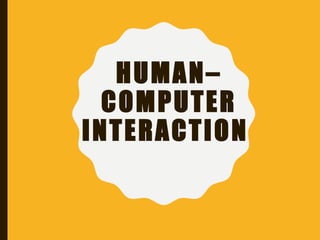
HCI.pptx
- 2. Purpose: to work with a system, the users need to be able to control the system and assess the state of the system.
- 3. PLAN • User interface, as a means of human- computer interaction. Usability of Interfaces. • Types of interfaces: command line interface, text interface, graphical interface, natural- language user interface • Mental characteristics of the user. • Stages of user interface development. • Types of interface testing (user testing). • Prospects for the development of interfaces.
- 4. USER INTERFACE, AS A MEANS OF HUMAN- COMPUTER INTERACTION Human–computer interaction (HCI) researches the design and use of computer technology, focused on the interfaces between people and computers.
- 5. USER INTERFACE The user interface (UI), in the industrial design field of human–computer interaction, is the space where interactions between humans and machines occur.
- 6. USABILITY
- 7. USABILITY OF INTERFACE Usability is the degree to which a software can be used by specified consumers to achieve quantified objectives with effectiveness, efficiency, and satisfaction in a quantified context of use. Usability of interface consists of Learnability Efficiency Memorability Errors Satisfaction
- 8. TYPES OF INTERFACES • command line interface • text interface • graphical interface • natural-language user interface
- 9. COMMAND-LINE INTERFACE A command-line interface is a means of interacting with a computer program where the user (or client) issues commands to the program in the form of successive lines of text (command lines).
- 10. TEXT-BASED USER INTERFACE Text-based user interface (TUI) is a user interface where by all output is presented in the form of text.
- 11. GRAPHICAL USER INTERFACE The graphical user interface (GUI ) is a type of user interface that allows users to interact with electronic devices through graphical icons and visual indicators such as secondary notation, instead of text-based user interfaces, typed command labels or text navigation.
- 12. XEROX ALTO
- 13. NATURAL-LANGUAGE USER INTERFACE • Natural-language user interface (LUI or NLUI) is a type of computer human interface where linguistic phenomena such as verbs, phrases and clauses act as UI controls for creating, selecting and modifying data in software applications.
- 14. MENTAL CHARACTERISTICS OF THE USER A mental model is a person’s intuitive understanding of how something functions based on his or her past encounters, exposure to information, and sound judgment.
- 15. HOW PEOPLE FORM MENTAL MODELS Observation Immersive Experience Culture
- 16. TIPS FROM FREE DESIGNERS • Try to learn something about users • Come up with your own characters • Brainstorm • Use common design patterns • Remember that we are all human, and we are all United by the same psychological principles
- 17. STAGES OF USER INTERFACE DEVELOPMENT User Flow Diagram Brainstorming & Sketching Understanding the Project’s Concept Factors of influence Choosing the Style of the Interface Structure and Flow Validation Style Validation
- 20. CHOOSING THE STYLE OF THE INTERFACE
- 21. CHOOSING AND CREATING THE PREVIEW FORM • Wireframe
- 22. CHOOSING AND CREATING THE PREVIEW FORM • Mockup
- 23. CHOOSING AND CREATING THE PREVIEW FORM • Clickable Prototype
- 24. CHOOSING AND CREATING THE PREVIEW FORM • Animated UI Flow
- 25. WHAT IS INTERFACE TESTING? Interface Testing is performed to evaluate whether systems or components pass data and control correctly to one another. It is to verify if all the interactions between these modules are working properly and errors are handled properly. Interface Testing - Checklist • Verify that communication between the systems are done correctly • Verify if all supported hardware/software has been tested • Verify if all linked documents be supported/opened on all platforms • Verify the security requirements or encryption while communication happens between systems • Check if a Solution can handle network failures between Web
- 26. TYPES OF INTERFACE TESTING This include testing each system individually. For example, billing system and inventory management system for retail store should be able to operate separately. This is considered when testing include date, month and day reversed A high-volume interface may require more Load Testing than a low- volume interface, depending on the interface engine and connectivity infrastructure Individual systems Edge cases -unexpected values Performance, load, and network testing It ensures that the interface engine handles your standard workflows as expected. Workflow
- 27. PROSPECTS FOR THE DEVELOPMENT OF INTERFACES
- 29. CHOOSE TWO CORRECT ANSWERS (TYPES OF INTERFACE) Object- oriented interface Command line interface Text user interface WIM interface
- 30. HCI UI MENTAL MODEL INTERFACE TESTING _________researche s the design and use of computer technology, focused on the interfaces between people and computers.
- 33. REFERENCES • Information and Communication Technologies Part 1: Textbook/ D.Shynybekov. - Almaty: IITU, 2017. - 588 p. • Information and Communication Technologies Part 2: Textbook/ D.Shynybekov. - Almaty: IITU, 2017. - 624 p • June J. Parsons and Dan Oja, New Perspectives on Computer Consepts 16th Edition - Comprehensive, Thomson Course Technology, a division of Thomson Learning, Inc Cambridge, MA, COPYRIGHT © 2014. • Lorenzo Cantoni (University of Lugano, Switzerland)James A. Danowski (University of Illinois at Chicago, IL,USA) Communication and Technologies, 576 pages • Craig Van Slyke Information Communication Technologies: Concepts, Methodologies, Tools, and Applications (6 Volumes)/ ISBN 13: 9781599049496, 2008, Pages: 4288 • Utelbaeva A.K.,Utelbaeva A.K. Study guide for lectures on discipline “Computer science”, Shimkent 2008, 84 pages.
- 34. JOBS